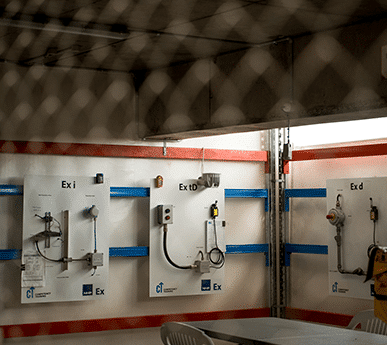Not known Factual Statements About Roar Solutions
Wiki Article
Roar Solutions - Truths
Table of ContentsEverything about Roar SolutionsThe Best Guide To Roar SolutionsA Biased View of Roar Solutions
In such an atmosphere a fire or explosion is feasible when 3 standard problems are satisfied. This is commonly described as the "dangerous area" or "combustion" triangle. In order to safeguard installations from a prospective explosion a method of analysing and categorizing a potentially unsafe area is needed. The function of this is to guarantee the correct option and installment of tools to inevitably prevent an explosion and to make certain safety and security of life.
(https://www.openlearning.com/u/thomascarrillo-snx8wb/about/)
No tools should be installed where the surface temperature level of the tools is more than the ignition temperature of the offered risk. Below are some typical dust unsafe and their minimum ignition temperature. Coal Dirt 380C 225C Polythene 420C (melts) Methyl Cellulose 420C 320C Starch 460C 435C Flour 490C 340C Sugar 490C 460C Grain Dust 510C 300C Phenolic Material 530C > 450C Aluminium 590C > 450C PVC 700C > 450C Soot 810C 570C The possibility of the threat being present in a concentration high adequate to trigger an ignition will vary from area to area.
In order to identify this risk an installation is divided right into locations of threat relying on the quantity of time the dangerous exists. These locations are referred to as Areas. For gases and vapours and dirts and fibres there are three areas. Area 0 Zone 20 A dangerous environment is very most likely to be existing and may be present for long periods of time (> 1000 hours annually) and even continuously Zone 1 Zone 21 A harmful ambience is possible however unlikely to be existing for extended periods of time (> 10 450 C [842 F] A classification of T6 implies the minimum ignition temperature is > 85 C [185 F] Dangerous location electric equipment possibly developed for usage in greater ambient temperatures. This would certainly suggested on the ranking plate e.g. EExe II C T3 Ta + 60C( This suggests at 60C ambient T3 will certainly not be surpassed) T1 T1, T2, T3, T4, T5, T6 T2 T2, T3, T4, T5, T6 T3 T3, T4, T5, T6 T4 T4, T5, T6 T5 T5, T6 T6 T6 A T Course rating of T1 implies the optimum surface area temperature generated by the tool at 40 C is 450 C. Thinking the linked T Class and Temperature level rating for the equipment are suitable for the area, you can constantly utilize an instrument with a much more rigorous Division score than needed for the area. There isn't a clear response to this concern sadly. It really does rely on the sort of tools and what repair work require to be performed. Devices with details test procedures that can not be performed in the field in order to achieve/maintain third celebration score. Need to return to the manufacturing facility if it is before the tools's solution. Field Repair Work By Authorised Employee: Complex testing may not be called for however specific procedures might need to be adhered to in order for the tools to keep its third party score. Authorised personnel should be employed to execute the job properly Repair need to be a like for like substitute. New part need to be thought about as a straight substitute requiring no unique testing of the devices after the repair work is full. Each item of equipment with a harmful rating ought to be examined separately. These are detailed at a high level listed below, but also for even more detailed information, please refer directly to the standards.
Not known Details About Roar Solutions
The tools register is a detailed database of equipment documents that includes a minimum set of fields to identify each product's area, technical parameters, Ex-spouse classification, age, and ecological data. The ratio of Comprehensive to Shut evaluations will certainly be figured out by the Equipment Risk, which is examined based on ignition danger (the possibility of a resource of ignition versus the probability of a combustible hop over to here ambience )and the dangerous area classification( Zone 0Area 1, or 2). Applying a robust Risk-Based Evaluation( RBI )approach is important for ensuring conformity and security in managing Electrical Tools in Hazardous Locations( EEHA).
The Definitive Guide to Roar Solutions

In terms of explosive threat, a harmful area is an environment in which an eruptive environment exists (or may be expected to be existing) in quantities that call for special preventative measures for the building, setup and use tools. eeha training. In this post we discover the difficulties dealt with in the office, the danger control actions, and the required proficiencies to work safely
These compounds can, in particular problems, create explosive atmospheres and these can have significant and tragic effects. Most of us are familiar with the fire triangle eliminate any kind of one of the 3 elements and the fire can not take place, however what does this mean in the context of unsafe areas?
In many circumstances, we can do little about the levels of oxygen airborne, but we can have considerable impact on sources of ignition, for instance electric devices. Dangerous locations are documented on the dangerous location classification illustration and are recognized on-site by the triangular "EX-SPOUSE" indicator. Here, amongst various other crucial details, zones are split into 3 types relying on the threat, the possibility and period that an explosive ambience will certainly exist; Area 0 or 20 is considered the most unsafe and Area 2 or 22 is deemed the least.
Report this wiki page